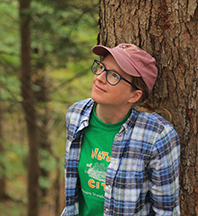Week of December 17, 2023 – December 23, 2023

by Anna Stunkel, Environmental Educator
Have you ever noticed something new while adventuring out in nature, but didn’t have a camera with you to capture an image? Perhaps it was a huge flock of migrating birds, a fox galloping across your path, or a beautiful flower that you’ve never seen before. If you carry a pocket sketchpad and a pencil, you will always have a way to visually record moments like these and help hold them in your memory throughout the seasons. Nature sketching is one of these hobbies that can be enjoyed by naturalists young and old, amateur and experienced. It can relieve stress and even feel like a form of meditation as you carefully map out the spines of a teasel plant or take a free-form approach to portraying an oak tree’s branches.
About a week ago, I had the opportunity to lead a workshop on sketching winter weeds here at Baltimore Woods. These plants have dried, their colors have faded, and only their seed heads and brownish gray forms remain at this time of year. Still, they provide endless opportunities for nature study and an important food source for wildlife. We spent part of the program collecting samples, cutting just a few of each plant species and bringing them back to the Interpretive Center. We then practiced portraying them on paper, using cotton swabs to blend fuzzy goldenrod seed heads and fluid pencil strokes to represent wiry stems. Participants were amazed by the diversity of these plants. Once their colors fade we have the chance to focus more closely on their shapes and patterns. And winter weeds sit still, so it’s easy to spend plenty of time getting to know them.
When I share the practice of nature sketching with others, I emphasize that we should focus on the fun and experience of the process rather than worrying too much about the product. As with any skill, sketching takes a lot of practice and patience. No matter how much you do it, you’ll be learning every single time! As you draw the arrangement of leaves on a stem or the shape of feathers on a bird’s wing, the action of putting pencil to paper will help you get to know and remember the beings who you meet in nature. You can look at the big picture, such as how a forest edge connects with a meadow in a landscape sketch. And you can use a hand lens to study the barbs on some burdock, carefully drawing the details. Sketching is just one tool that helps us to grow as naturalists while relaxing and connecting with our surroundings.
If you’re interested in learning more, I will be leading a program on January 19 all about sketching birds. Check out our website at baltimorewoods.org to sign up; we hope to see you there!

